IDC presented its annual HPC Update at ISC yesterday. As usual it was a whirlwind tour encompassing HPC market data, technology trends, new IDC initiatives, announcement of the ISC16 Innovation Award recipients, and an update on IDC’s DOE-funded study to demonstrate HPC’s ROI. Small wonder it required an 81-slide deck with Earl Joseph and Bob Sorensen of IDC ably sharing the presenter duties.
Before plunging into the details here are a few key summary bullets:
- 2015 was an excellent year (11 percent revenue growth) but 2016 is likely to be only “OK’. That said, HPC remains a growth market with the migration of HPC to the cloud and growing recognition of HPC’s strategic value as key market drivers. The forecast for 2015-2020 server growth, however, is a modest 5.9 percent.
- Vendor positions “shifted greatly” and will keep shuffling according IDC. This year’s winner in supercomputers is Hewlett Packard Enterprise among named vendors while the unglamorous ‘Other’ category, a bit of a catchall bucket, is growing in size and impact reported IDC. Joseph said IDC is thinking about identifying some of the companies lumped together in the category.
- The formative HPDA continues its growth and will expand vendor opportunities, said Joseph. So will machine learning, cognitive computing, and IoT. Encouragingly HPC ROI numbers are even higher than first indicated in IDC’s pilot study – the latest data suggest $1 invested produces $673 in revenue and $44 in profits (or savings) though Joseph added a caution. On the downside, software remains the number one roadblock for users, cluster management is still not trivial, and
- Here comes China. Rumors had swirled for some time but the sudden reality of China’s new supercomputer (the Sunway TaihuLight system, 40,960 nodes and 10,649,600 cores and 1.31 PB of memory) appearing atop the latest Top500 list will cause consternation in many quarters. The new computing colossus is also complicating IDC’s efforts to size the supercomputer market because IDC isn’t sure how to count it, says Joseph. No matter how it ends up being counted, it changes the landscape.
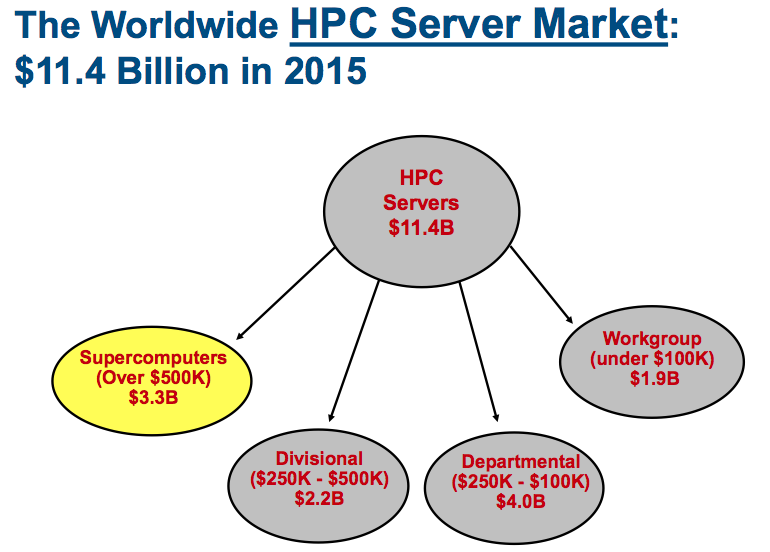 Here’s a quick look at IDC’s top line HPC revenue numbers. 2015 server market sales are shown on the first slide followed by IDC’s five-year forecast below. The trend moving forward is positive but hardly bullish.
Here’s a quick look at IDC’s top line HPC revenue numbers. 2015 server market sales are shown on the first slide followed by IDC’s five-year forecast below. The trend moving forward is positive but hardly bullish.
In terms of the overall HPC market, storage is still the fastest growing segment. IDC estimate 2015 revenue at $4.7B growing to $6.7B in 2019 – that’s 9.4 percent CAGR and indicative of the growth of big data and HPDA requirements. Servers and services are forecast to grow 7.7percent over the same time period. Virtually no growth is forecast for any server segment for the 2019-2020 period pulling down its five-year growth average to 5.9 percent as noted earlier.
Joseph noted the supercomputer segment in particular poses several challenges in characterizing. Sales cycles are variable and one or two big contracts can change revenue totals. The supercomputer market sales curve still has that roller coaster shape. “If you look at just the top three or four supercomputers sold each year, that’s what is causing all the variation here,” he said.
Taking about Sunway, he said “There are a number of definitions as to how it fits our data structure and we have to determine was it actually sold to somebody or was it self-built. At the moment it looks like it might have been self built. If it is self built it doesn’t go into our data structure because we don’t track things that are not built by [one party] and then sold to someone else.” He says it will be a month before they sort how to account for Sunway – if it is not included the segment will show no growth in 2016.
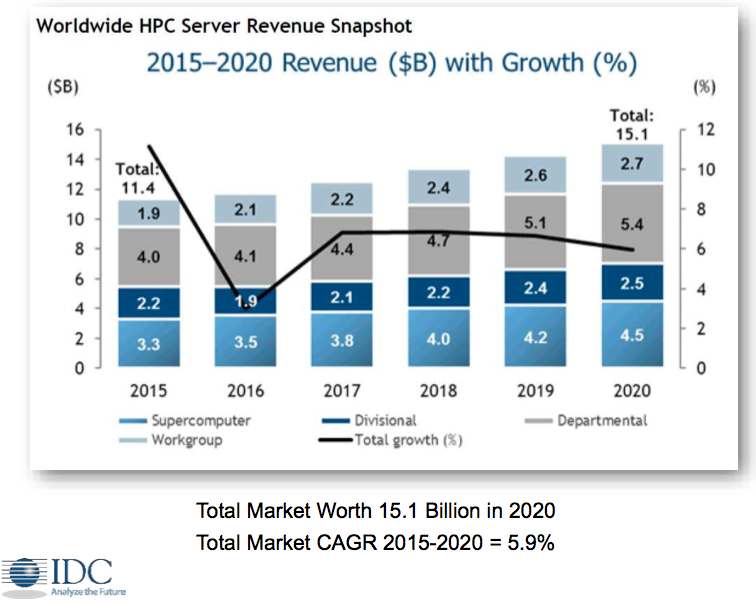
HPE/HP (2015 sales) led the pack of ten named supercomputer suppliers with $1.2B. Cray was nearest ($583M), followed by Lenovo ($391M), NEC ($138M), Fujitsu ($106M), SGI ($88M), Dell ($54M), Bull Atos ($41M) and Sugon ($13M). The ‘Other’ category was actually third with $422M.
You can see quickly see how big the ‘other’ category has become, says Sorensen adding, “It’s a collection of vendors that are either too small to be included individually or who don’t want their actual numbers broken out in any great detail. What we are finding is this other category is growing rather aggressively.”
Having followed the HPDA market for time now, IDC continues to refine how it tracks the space. Joseph said IDC recently begun characterizing HPDA in four categories:
- Fraud and anomaly detection. This “horizontal” workload segment centers around identifying harmful or potentially harmful patterns and causes using graph analysis, semantic analysis, or other high performance analytics techniques. The patterns may point to fraud, which is the deceptive exploitation or annotation of data for wrongful or illegal personal gain, or they may point to cyber security crime or insider threats, significant errors, or other anomalies that may deserve further investigation.
- Marketing. This segment covers the use of HPDA to promote products or services, typically using complex algorithms to discern potential customers’ demographics, buying preferences and habits.
- Business intelligence. The workload segment uses HPDA to identify opportunities to advance the market position and competitiveness of businesses, by better understanding themselves, their competitors, and the evolving dynamics of the markets they participate in.
- Other Commercial HPDA. This catchall segment includes all commercial HPDA workloads other than the three just described. Over time, IDC expects some of these workloads to become significant enough to split out of this “other” category and command their own segments. An example of such a high-potential workload is the use of HPDA to manage large IT infrastructures, ranging from on premise data centers to public clouds and Internet-of-Things (IoT) infrastructures.
Joseph said IDC plans to add segments but how many and when isn’t set.
There were few surprises on IDC hit list of important technologies. Despite Intel’s current dominance in the processor world, a point hammered home at ISC this week with release of Xeon Phi/KNL to general availability, the camp of alternatives continues to grow rather than shrink. The interconnect battle between Intel Omni-Path and Mellanox InfiniBand is also now in full swing said Sorensen. Shown here are some of the technologies 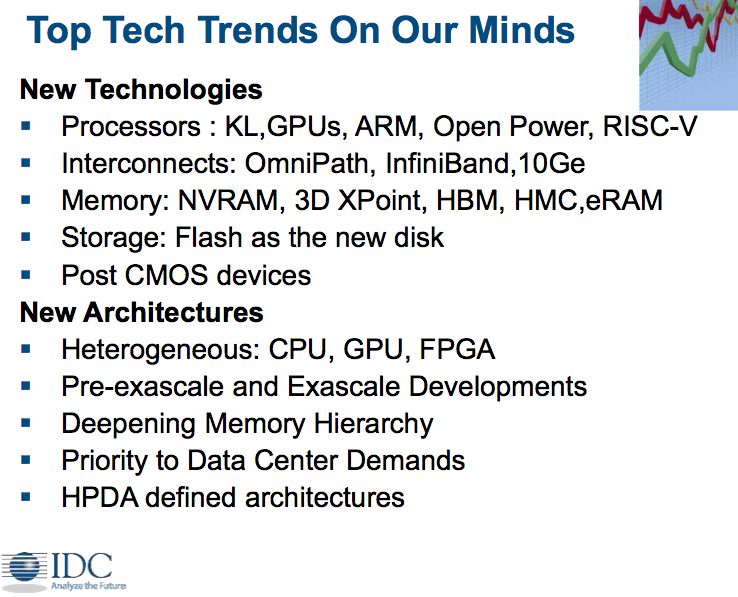 IDC is watching closely
IDC is watching closely
Software challenges are perhaps even more vexing, said Sorensen noting wryly the rush to use the word open – as in OpenHPC, OpenCL, Open ACC, Open Stack, Open Power, an Open Compute (his list).
IDC touched on two new DOE-funded initiatives it’s undertaking. One is a program to track exascale activity around the world. Sorensen explained, “[The idea] is to track, on a quarterly basis, where are the projects, who are the principal investigators, what’s the level of funding, what are the research goals.”
As part of the grant, IDC is supposed to share its results with the HPC community. “Part of the reason this is being made available to the whole community is to help government users and vendor figure out where is the best place to make an R&D investment. The tracking will show holes, where things are missing,” he said.
The mechanism hasn’t yet been sorted out but IDC plans to create a data structure and repository that’s updated every quarter and is made available. “We’d very much like to do it by Supercomputing (November) but I have to say I think we’re going to miss that by about a month.”
The other effort is around cyber security. IDC has already done one study examining problems and practices in how organizations handle cyber security. As described by Sorensen, the results of the early work are not especially comforting. For example, the study reveled that detecting a breach can take a couple of years from the time of its occurrence. “Worse,” said Sorensen, “when something like that happens, rather than fix the problem, organization often simply opt by more insurance.”
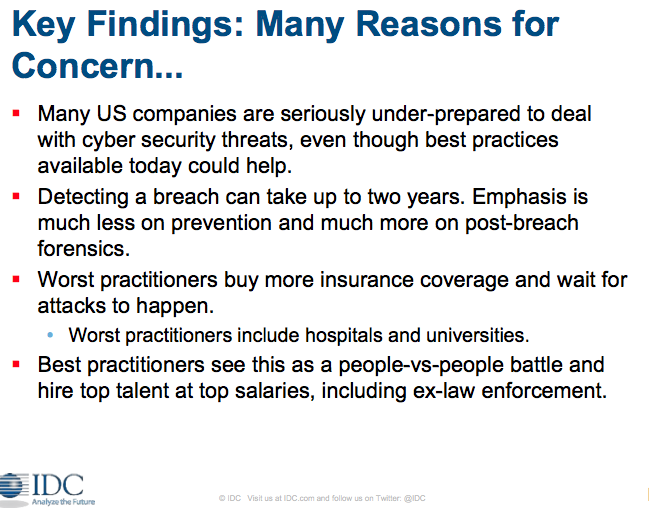 The first study was done in the summer of 2015. This next phase will drill down further in an effort to identify effective technologies and best practices. Cyber security isn’t necessarily an HPC issue, agrees Sorensen, but it usually is a HPDA issue and often other HPC elements can be deployed. A few conclusions from the first study are shown here.
The first study was done in the summer of 2015. This next phase will drill down further in an effort to identify effective technologies and best practices. Cyber security isn’t necessarily an HPC issue, agrees Sorensen, but it usually is a HPDA issue and often other HPC elements can be deployed. A few conclusions from the first study are shown here.
The 2016 study is designed “to obtain relevant, useful information from large US organizations concerning their cyber security challenges and how they’re addressing those challenges from strategic, proactive, reactive, and crisis management perspectives.” A critical element in the study, says IDC, is exploring the role that HPDA/Big Data analytics can play in advanced cyber security.
Besides discussing the new DOE sponsored programs, IDC also provided an update on its various efforts to establish ROI metrics for HPC. This project has been going on for some time. The early pilot program produced very promising results (HPC ROI: Invest a Dollar to Make $500-plus Reports IDC). IDC has since moved been working on building up the number of samples in the study to refine the results and increase confidence in them.
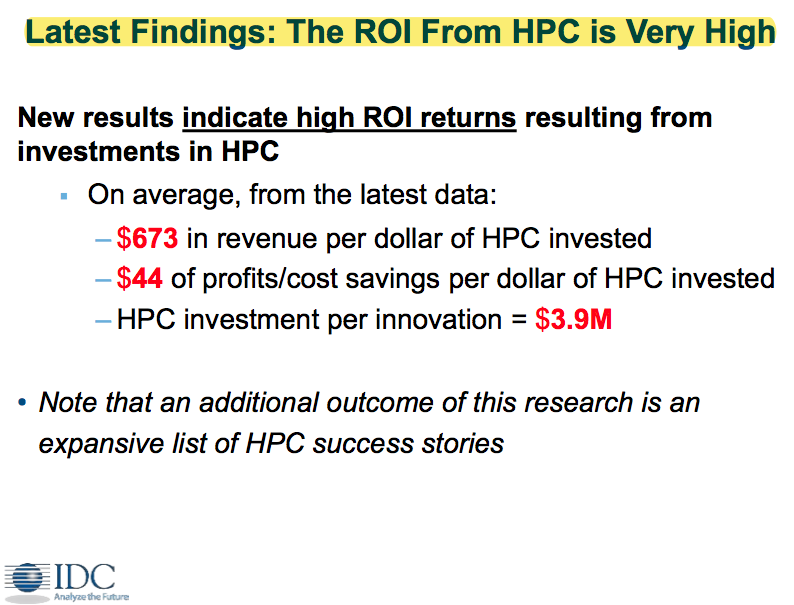 The new results shown were rather dramatically higher that the pilot, making some in the audience wondered how that could be. Joseph agreed.
The new results shown were rather dramatically higher that the pilot, making some in the audience wondered how that could be. Joseph agreed.
“The initial work was to create the model. Now we are at the large scale data collection [stage],” said Joseph. “Our feeling right now is we are going to need about 2000 samples” to have solid confidence in the results. Even so, said Joseph, DOE was now encouraging IDC “to getting the data out to the community more frequently and to create much more information about HPC’s job creation potential.”



























































